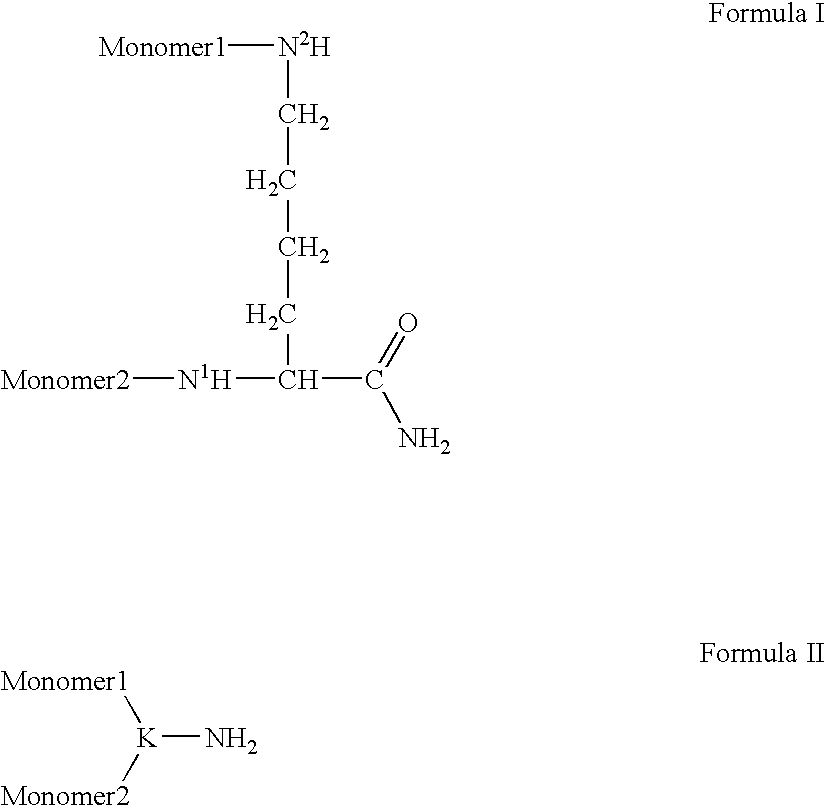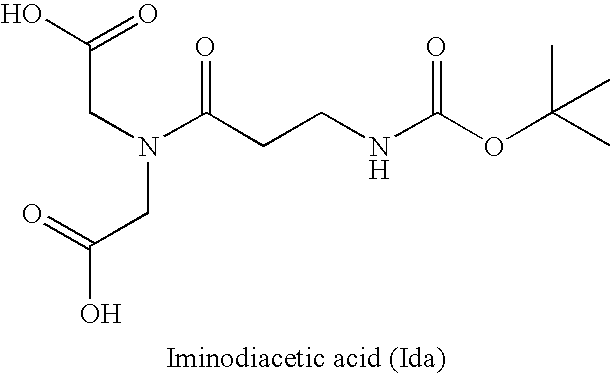Compositions and Methods for Inhibiting Cellular Proliferation
a technology of cellular proliferation and composition, applied in the field of compositions for inhibiting cellular proliferation, can solve the problems of increased thickness of lesion, increased risk of metastasis, and tumors progressing to large cavernous and infiltrative forms, so as to prevent the formation of capillaries, inhibit the development of disease and tumor growth, and have few side effects
- Summary
- Abstract
- Description
- Claims
- Application Information
AI Technical Summary
Benefits of technology
Problems solved by technology
Method used
Image
Examples
example 1
Synthesis of a Dimeric Peptide on TentaGel-Rink Resin
[0141]
[0142] TentaGel-Rink resin: The synthesis was carried out on an Aaptec model 90 solid-phase peptide synthesizer. Step 1: TentaGel-Rink resin (25.0 g, 0.2 mmol / g from Rapp Polymere, Germany) was treated with 150 mL of a solution of 20% piperidine in DMF (1×2 min, 1×25 min). Step 2: The resin was washed (DMF, DCM, MeOH, DMF, 150 mL). Step 3: The resin was treated with an activated solution of Fmoc-AA-OH (prepared from 4 eq. amino acid and 4 eq. HOBt in DMF (0.25 M), followed by the addition of 4 eq. of DIC in DMF, 0.25 M) and allowed to mix for 2 hours. Step 4: The resin was treated for a second time with an activated solution of Fmoc-AA-OH (prepared from 4 eq. amino acid and 4 eq. HOBt in DMF (0.25 M), followed by the addition of 4 eq. of DIC in DMF, 0.25 M) and allowed to mix for 2 hours. Step 5: The resin was washed (DCM, MeOH, DMF, 150 mL) and steps 1-5 were repeated until the desired dimeric peptide sequence was obtained...
example 2
Synthesis of a Linear Peptide on TentaGel-Rink Resin
[0145]
[0146] TentaGel-Rink resin: The synthesis was carried out on an Aaptec model 90 solid-phase peptide synthesizer. Step 1: TentaGel-Rink resin (25.0 g, 0.2 mmol / g from Rapp Polymere, Germany) was treated with 150 mL of a solution of 20% piperidine in DMF (1×2 min, 1×25 min). Step 2: The resin was washed (DMF, DCM, MeOH, DMF, 150 mL). Step 3: The resin was treated with an activated solution of Fmoc-AA-OH (prepared from 4 eq. amino acid and 4 eq. HOBt in DMF (0.25 M), followed by the addition of 4 eq. of DIC in DMF, 0.25 M) and allowed to mix for 2 hours. Step 4: The resin was washed (DCM, MeOH, DMF, 150 mL) and steps 1-4 were repeated until the desired linear peptide sequence was obtained. After the final Fmoc removal, the terminal amine groups were acylated by treating the resin with a solution of 10% acetic anhydride, 20% pyridine in THF (150 mL) for 40 minutes, followed by washing (DCM, MeOH, DMF, 150 mL). The resin was drie...
example 3
Dimerization and PEGylation Using a Trifunctional Amine Linker and a Trifunctional Molecule
[0148] A first trifunctional molecule having the structure
was made according to the following:
[0149] To a solution of Boc-βAla-OH (10.0 g, 52.8 mmol) (Boc=tert-butoxycarbonyl) and diethyl iminodiacetate (10.0 g, 52.8 mmol) in 200 mL of DCM at 0° C. was added DCC (10.5 g, 50.9 mmol) over 5 minutes. A white precipitate formed within 2 minutes. The reaction mixture was allowed to warm to room temperature and was stirred for 24 hours. The urea was filtered off with a sintered filter (medium porosity) and the solvent removed under reduced pressure. The residue was taken up in 500 mL of EtOAc (EtOAc=ethyl acetate), filtered as above, and transferred to a separatory funnel. The organic phase was washed (sat. NaHCO3, brine, 1 N HCl, brine), dried (MgSO4), filtered, and dried to yield a colorless oil. The oil solidified to yield a white crystalline solid within 10 minutes.
[0150] The crude dieste...
PUM
| Property | Measurement | Unit |
|---|---|---|
| volume | aaaaa | aaaaa |
| diameter | aaaaa | aaaaa |
| size | aaaaa | aaaaa |
Abstract
Description
Claims
Application Information
 Login to View More
Login to View More - R&D
- Intellectual Property
- Life Sciences
- Materials
- Tech Scout
- Unparalleled Data Quality
- Higher Quality Content
- 60% Fewer Hallucinations
Browse by: Latest US Patents, China's latest patents, Technical Efficacy Thesaurus, Application Domain, Technology Topic, Popular Technical Reports.
© 2025 PatSnap. All rights reserved.Legal|Privacy policy|Modern Slavery Act Transparency Statement|Sitemap|About US| Contact US: help@patsnap.com



